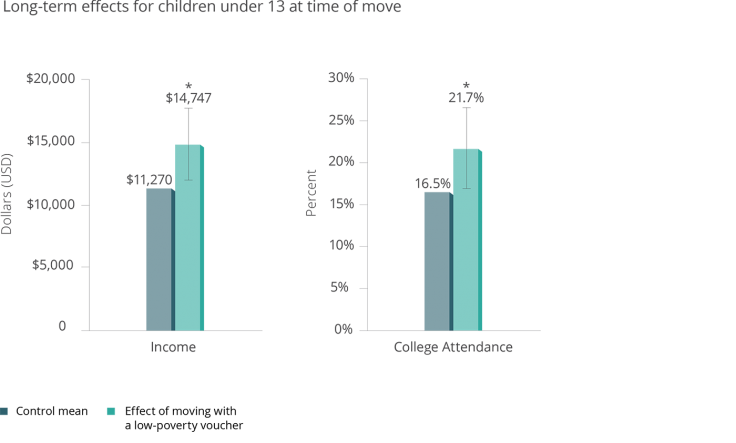Creating Moves to Opportunity

The Creating Moves to Opportunity (CMTO) project is an ongoing collaboration between J-PAL-affiliated researchers and public housing authorities (PHAs) to introduce and evaluate interventions to “create moves to opportunity” for low-income families.
Although the United States spends $20 billion annually on the Housing Choice Voucher program, more than 80 percent of vouchers are used in moderate- or high-poverty neighborhoods. Supported by J-PAL North America, MDRC, non-profit housing practitioners, housing advocates, foundations, and government partners, researchers and public housing authorities are working together to test programs designed to help families who receive Housing Choice Vouchers to exercise housing choice and move to higher opportunity neighborhoods.
MOTIVATION
A wave of emerging research following the Moving to Opportunity experiment provides new evidence that growing up in a high-poverty neighborhood has a negative effect on a number of important life outcomes, while helping families move to lower-poverty neighborhoods improves long-term outcomes for their children, thereby promoting upward mobility.
Long-term analysis of the Moving to Opportunity (MTO) experiment finds that young children (under age 13) whose families were randomly provided vouchers to move from high-poverty housing projects to lower-poverty neighborhoods earned substantially more in adulthood, were more likely to attend college, attended higher-quality colleges on average, and were less likely to become single parents. Chetty and Hendren find that every year a child spends growing up in a better neighborhood improves their outcomes in adulthood, including earnings and college attendance.

The importance of place for upward economic mobility suggests at least two policy approaches: (1) improve low-opportunity neighborhoods, and (2) help families with young children move to high-opportunity neighborhoods. Though all partners in the CMTO effort recognize and remain committed to improving America’s most disadvantaged neighborhoods, CMTO focuses on the second approach by developing and evaluating potential interventions to facilitate long-lasting moves to opportunity through the Housing Choice Voucher program, particularly for families with young children.
PROJECT GOALS
The primary goal of this collaboration is to understand how to facilitate moves to better neighborhoods. As such, the two primary outcomes of interest to the research team are:
- the number of moves to opportunity neighborhoods made by families, particularly those with younger children; and
- how long families stay in those neighborhoods.
Watch Greg Russ, then Cambridge Housing Authority Executive Director, and
J-PAL North America Scientific Director Larry Katz talk about the genesis of CMTO.
CURRENT RESEARCH
Seattle-King County CMTO Demonstration Project
The Seattle Housing Authority and King County Housing Authority are partnering with researchers to evaluate whether mobility services are effective at encouraging families with children to move to higher-opportunity neighborhoods. Families applying for Housing Choice Voucher Program assistance that choose to participate in the study are randomly assigned to a one of two research groups. Those assigned to receive CMTO services are offered the mobility services including rental application coaching, opportunity area education, housing search assistance, and flexible financial assistance; while the other group are offered a Housing Choice Voucher and all standard services offered by the housing authorities.
Preliminary results from the first year of the ongoing evaluation demonstrate that the suite of CMTO services are effective in helping families move to high-opportunity areas. Fifty-four percent of families in the CMTO services group chose to move to high-opportunity areas, compared to 14 percent of families in the standard services group. These preliminary results suggest that many low-income families are concentrated in areas of lower opportunity because of barriers that prevent them from moving to higher-opportunity areas, rather than preferences for living in areas with lower opportunity. The project is currently evaluating whether families will persist in their new neighborhoods.
The second year of the study will test new iterations of the existing services to determine whether different approaches to service delivery will be more or less effective in supporting moves to areas of higher opportunity.
Read a more detailed description of the project.
Read a more detailed summary of this evaluation and results.
Informing and Nudging Families to Opportunity
This project will add neighborhood quality information onto housing listings on the GoSection8 website, the largest provider of housing listings available to housing voucher recipients, and will conduct outreach to landlords to increase the number of listed units in high-opportunity neighborhoods. Researchers will evaluate how introducing information on neighborhood quality impacts demand for listings on the web and mobile sites, and whether increased outreach to landlords increases the supply of listings in higher opportunity neighborhoods available to voucher-holders. This research will be conducted by randomly selecting users of the GoSection8 platform and partnering with several PHAs to do outreach to landlords.
Read a more detailed summary of this evaluation.
PARTNERS
The CMTO research team is led by Peter Bergman, Raj Chetty, Stefanie Deluca, Nathaniel Hendren, Lawrence Katz, and Christopher Palmer. MDRC is leading project development and implementation for CMTO.
Participating Public Housing Authorities include Seattle, Tacoma, and King County, Washington; HomeForward in Portland, Oregon; Fresno Housing Authority, San Bernardino County, and San Diego, California; Dallas and Houston, Texas; Minneapolis and the Metropolitan Council Housing and Redevelopment Authority in Minnesota; Cook County, Illinois; Louisville, Kentucky; Atlanta, Georgia; Charlotte, North Carolina; Washington, DC; NYC Housing Preservation & Development, New York; Boston, Cambridge, and the Department of Housing and Community Development in Massachusetts; and Keene County, New Hampshire.
For more information, please visit our partner's webpages:
- Opportunity Insights: Experimental Evidence on Barriers to Neighborhood Choice
- MDRC: Creating Moves to Opportunity

Learn More
To learn more about CMTO, please visit Opportunity Insights